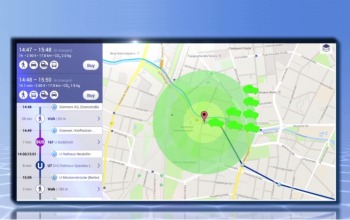Intelligent Algorithm Finds Available Carsharing Vehicles

The forecasting tool will be incorporated into the integrated SiMobility Connect mobility platform, which links carsharing firms, public transport companies, taxis, and bike-rental services.
Customers will then be able to use just one app to plan all segments of their trip and immediately see which combinations of transport modes are most advantageous at the moment or at a later time. The goal is to make the planning of inter-modal journeys (combinations of different forms of transport) more effective in order to combat growing traffic congestion in metropolitan areas. The new software also incorporates car-sharing users whose cars do not have a permanent parking space.
This “free floating carsharing” is a relatively new concept made possible by state-of-the-art information technology systems. The vehicles here do not have a permanent location but can instead be parked anywhere within a specific region.
They then report their position to a control center. Users can then check the current availability of vehicles in their area with an app and book a car right when they're ready to take it. This system offers the benefit of great flexibility because vehicles no longer have to be returned to a specific place at a set time. Planning is more difficult, however, because the cars cannot be booked well in advance and users cannot be sure whether a vehicle will be available at an acceptable distance from the desired location in the future.
Position of all carsharing vehicles in realtime
The researchers from Siemens Corporate Technology focused on this aspect. They developed an algorithm that uses realtime data on the position of all carsharing vehicles to predict where and when they will be available in the future. The process begins with historical data on the locations and availability of all vehicles over time.
When such data is monitored over a longer period, it becomes possible to recognize patterns in the distribution of vehicles, and these patterns can then be used to make forecasts. A range of external influencing factors, such as weather, holidays, vacation periods, and major events, can also be incorporated into the analyses. The distribution of cars will also be affected by measures taken by carsharing firms, such as the provision of additional vehicles.
In order to manage this huge amount of data, the researchers divide the area for which forecasts are to be made into individual grid cells. The algorithm uses the historical data on these cells to learn how to predict future vehicle distribution as accurately as possible. The learned model gets better as the amount of data increases over time, which means its predictions become increasingly accurate even when it's already operating.
If the algorithm is integrated into a trip-planning app, users can look up the probability that a vehicle will be available within a user-defined radius of their desired location, thus enabling them to better plan their journey. Carsharing firms benefit from the app because it helps them utilize their vehicles more effectively.
Press Picture: http://www.siemens.com/press/en/presspicture/innovationnews/2015/im2015010379coe…
Media Contact
All latest news from the category: Information Technology
Here you can find a summary of innovations in the fields of information and data processing and up-to-date developments on IT equipment and hardware.
This area covers topics such as IT services, IT architectures, IT management and telecommunications.
Newest articles

Silicon Carbide Innovation Alliance to drive industrial-scale semiconductor work
Known for its ability to withstand extreme environments and high voltages, silicon carbide (SiC) is a semiconducting material made up of silicon and carbon atoms arranged into crystals that is…

New SPECT/CT technique shows impressive biomarker identification
…offers increased access for prostate cancer patients. A novel SPECT/CT acquisition method can accurately detect radiopharmaceutical biodistribution in a convenient manner for prostate cancer patients, opening the door for more…

How 3D printers can give robots a soft touch
Soft skin coverings and touch sensors have emerged as a promising feature for robots that are both safer and more intuitive for human interaction, but they are expensive and difficult…





















